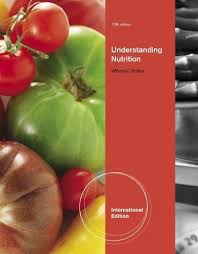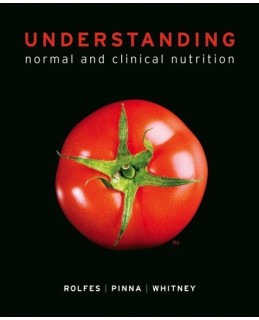Description
Understanding Nutrition International Edition 13th Edition By Eleanor Noss Whitney – Test Bank
Table of Contents
A Note on Test Bank Style and Use iv
Part 1 – Test Bank for Understanding Nutrition 1
Chapter 1 – An Overview of Nutrition 1
Chapter 2 – Planning a Healthy Diet 15
Chapter 3 – Digestion, Absorption, and Transport 29
Chapter 4 – The Carbohydrates: Sugars, Starches, and Fibers 46
Chapter 5 – The Lipids: Triglycerides, Phospholipids, and Sterols 64
Chapter 6 – Protein: Amino Acids 85
Chapter 7 – Energy Metabolism 103
Chapter 8 – Energy Balance and Body Composition 118
Chapter 9 – Weight Management: Overweight, Obesity, and Underweight 132
Chapter 10 – The Water-Soluble Vitamins: B Vitamins and Vitamin C 148
Chapter 11 – The Fat-Soluble Vitamins: A, D, E, and K 171
Chapter 12 – Water and the Major Minerals 188
Chapter 13 – The Trace Minerals 207
Chapter 14 – Fitness: Physical Activity, Nutrients, and Body Adaptations 228
Chapter 15 – Life Cycle Nutrition: Pregnancy and Lactation 245
Chapter 16 – Life Cycle Nutrition: Infancy, Childhood, and Adolescence 264
Chapter 17 – Life Cycle Nutrition: Adulthood and the Later Years 285
Chapter 18 – Diet and Health 299
Chapter 19 – Consumer Concerns about Foods and Water 317
Chapter 20 – Hunger and the Global Environment 338
Part 2 – Test Bank for Nutrition Pathways Telecourse Videos 349
(Provided by Marie Yost Maness of Dallas County Community College District)
Lesson 1: Nutrition Basics 349
Lesson 2: The Digestive System 351
Lesson 3: Carbohydrates: Simple and Complex 353
Lesson 4: Carbohydrates: Fiber 354
Lesson 5: Fats: The Lipid Family 357
Lesson 6: Fats: Health Effects 359
Lesson 7: Protein: Form and Function 361
Lesson 8: The Protein Continuum 363
Lesson 9: Metabolism 364
Lesson 10: Weight Control: Energy Regulation 365
Lesson 11: Weight Control: Health Effects 367
Lesson 12: Vitamins: Water-Soluble 370
Lesson 13: Vitamins: Fat-Soluble 371
Lesson 14: Major Minerals and Water 373
Lesson 15: Trace Minerals 376
Lesson 16: Physical Activity: Fitness Basics 379
Lesson 17: Physical Activity: Beyond Fitness 382
Lesson 18: Life Cycle: Pregnancy 384
Lesson 19: Life Cycle: Lactation and Infancy 386
Lesson 20: Life Cycle: Childhood and Adolescence 388
Lesson 21: Life Cycle: Adulthood and Aging 390
Lesson 22: Diet and Health: Cardiovascular Disease 392
Lesson 23: Diet and Health: Cancer, Immunology, and AIDS 395
Lesson 24: Diet and Health: Diabetes 399
Lesson 25: Consumer Concerns and Food Safety 402
Lesson 26: Applied Nutrition 405
Chapter 2 – Planning a Healthy Diet
Multiple Choice
1. A person’s customary intake of foods and beverages over time defines her or his
a. body weight.
b. eating pattern.
c. genetic predisposition.
d. risk for inherited diseases.
2. The diet-planning principle that provides all the nutrients, fiber, and energy in amounts sufficient to maintain health is called
a. variety.
b. adequacy.
c. moderation.
d. kcalorie control.
3. What are the principles of diet planning?
a. Abundance, B vitamins, kcalories, diet control, minerals, and variety
b. Abundance, balance, conservative, diversity, moderation, and vitamins
c. Adequacy, bone development, correction, vitamin density, master, and variety
d. Adequacy, balance, kcalorie control, nutrient density, moderation, and variety
4. Which of the following is the most calcium-dense food?
a. Whole milk
b. Nonfat milk
c. Low-fat milk
d. Cheddar cheese
5. Nutrient dense refers to foods that
a. carry the USDA nutrition labeling.
b. are higher in weight relative to volume.
c. provide more nutrients relative to kcalories.
d. contain a mixture of carbohydrate, fat, and protein.
6. The concept of nutrient density is most helpful in achieving what principle of diet planning?
a. Variety
b. Balance
c. Moderation
d. kCalorie control
7. Which of the following is an expression of the nutrient density of a food?
a. 0.01 mg iron per kcalorie
b. 110 kcalories per cup
c. 0.5 mg iron per serving
d. 110 kcalories per serving
8. An empty-kcalorie food is one that contains
a. no kcalories.
b. an abundance of vitamins but little or no minerals.
c. an abundance of minerals but little or no vitamins.
d. energy and little or no protein, vitamins, or minerals.
9. A food that provides 100 mg of magnesium and 25 kcal in a serving has a magnesium density (mg per kcal) of
a. 0.4
b. 4
c. 250
d. 2500
10. Ranking foods according to their overall nutrient composition is known as
a. biological value.
b. nutrient profiling.
c. the risk reduction score.
d. the healthy eating index.
11. Providing enough, but not an excess, of a food is a diet-planning principle known as
a. safety.
b. variety.
c. moderation.
d. undernutrition.
12. Applying the principle of variety in food planning ensures the benefits of
a. moderation.
b. vegetarianism.
c. nutrient density.
d. dilution of harmful substances.
13. Which of the following practices is NOT consistent with achieving a healthy diet?
a. Intake of eggs
b. Intake of nuts
c. Emphasis on solid fats
d. Emphasis on low-fat milk products
14. Which of the following is among the recommendations of the Dietary Guidelines for Americans?
a. Increase physical activity
b. Limit protein foods intake
c. Practice good foot hygiene
d. Reduce seafood consumption
15. Which of the following is NOT a feature of daily sodium intake guidelines?
a. The intake for most people should be <2300 mg
b. The intake for African-Americans should be ≤1500 mg
c. The intake should be limited to 10% of total mineral intake
d. The intake for most people ≥51 yrs of age should be ≤1500 mg
16. The Dietary Guidelines for Americans 2010 are applicable to all population groups except
a. pregnant teenagers.
b. people who are super-obese.
c. children under 2 years of age.
d. seniors older than 80 years of age.
17. Which of the following is NOT among the features of a food group plan?
a. Defines portion sizes
b. Considered a tool for diet planning
c. Sorts foods of similar water content
d. Specifies the amounts of food from each group
18. An important feature of the food group subgroupings is that
a. all vegetables do not provide an array of nutrients.
b. consuming legumes supplies protein but not fiber or vitamins.
c. it is not necessary to consume every subgroup every day.
d. it is acceptable to consume broccoli every day for a week to meet the vegetables group intake.
19. Consider the following menu from the point of view of the USDA Food Patterns.
|
Breakfast 2 eggs 1 tsp margarine 2 slices enriched white bread 1 c whole milk coffee |
Lunch 2 oz tuna fish lettuce 1 tbsp mayonnaise 2 slices enriched white bread 1 apple |
|
Supper 3 oz hamburger meat 1 oz cheese ½ c cooked rice ½ c carrots coffee |
Which of the following describes the nutritional value of the fruits and vegetables in this menu?
a. A source of vitamin A is missing
b. A source of vitamin C is marginal
c. The daily amounts recommended for a 2000-kcalorie diet are met
d. The daily amounts recommended for a 2000-kcalorie diet are exceeded
20. Jamie is a vegetarian who is trying to plan a healthy diet according to the USDA Food Patterns. Which of the following protein foods would be the best nutrient choices for one day?
a. 2 pieces bacon, 1/2 can tuna, 2 pieces bread
b. 1/2 cup pinto beans, 1/2 cup tofu, 2 tbsp peanut butter
c. 1/2 cup black beans, 2 tbsp peanut butter, 1 c spinach
d. 1 skinless chicken breast, 2 egg whites, meal replacement bar
21. What two major nutrients are supplied by the fruit and vegetable groups?
a. Vitamins D and E
b. Vitamins A and C
c. Protein and calcium
d. B vitamins and iron
22. Which of the following is NOT characteristic of the USDA Food Patterns?
a. They place most foods into one of five groups
b. The nutrients of greatest concern include iron, chromium, and vitamin B12
c. They can be used with great flexibility once their intent is understood
d. They specify that a certain quantity of food be consumed from each group, based upon energy intake





Be the first to review “Understanding Nutrition International Edition 13th Edition By Eleanor Noss Whitney – Test Bank”